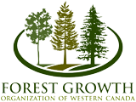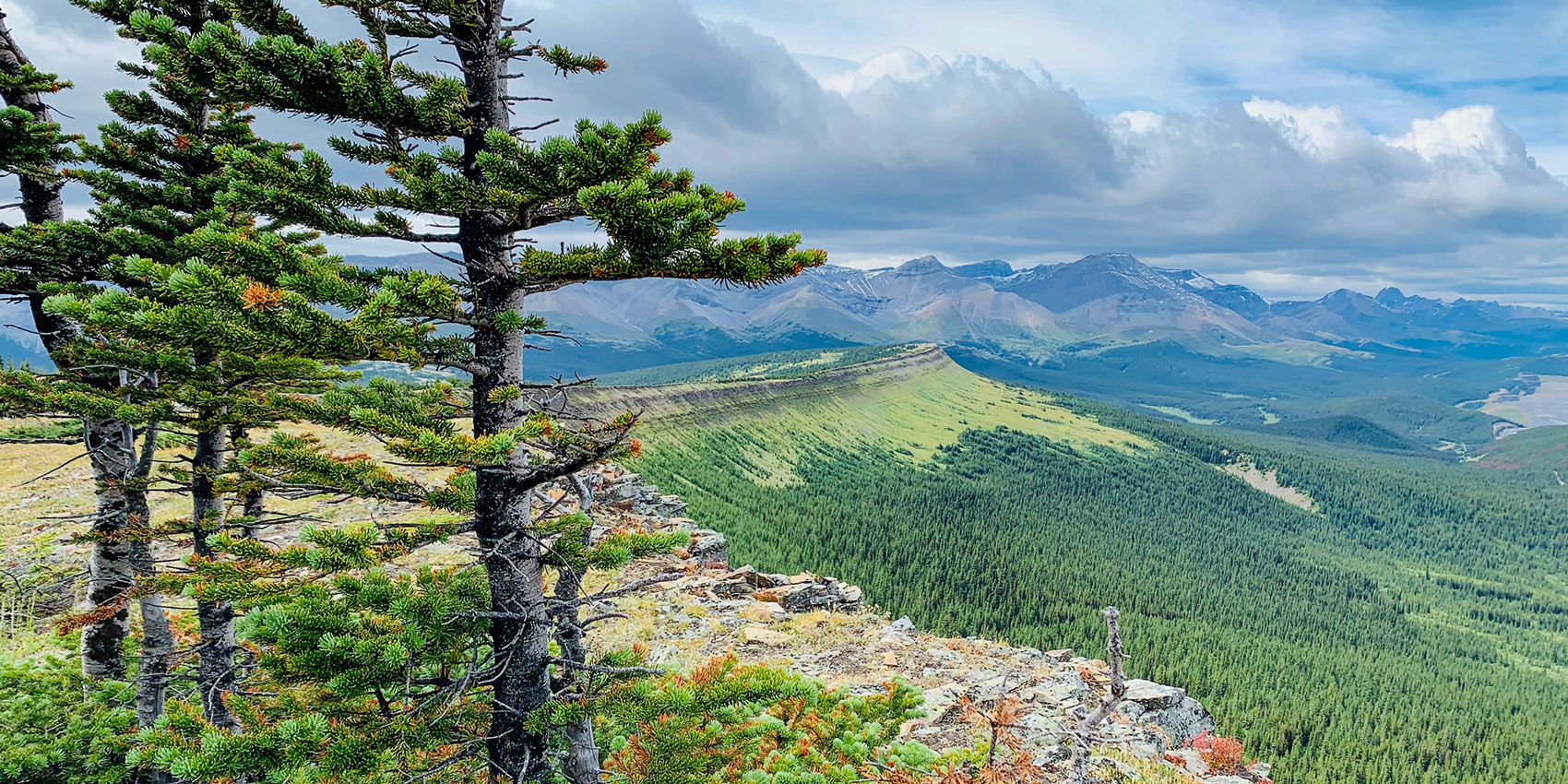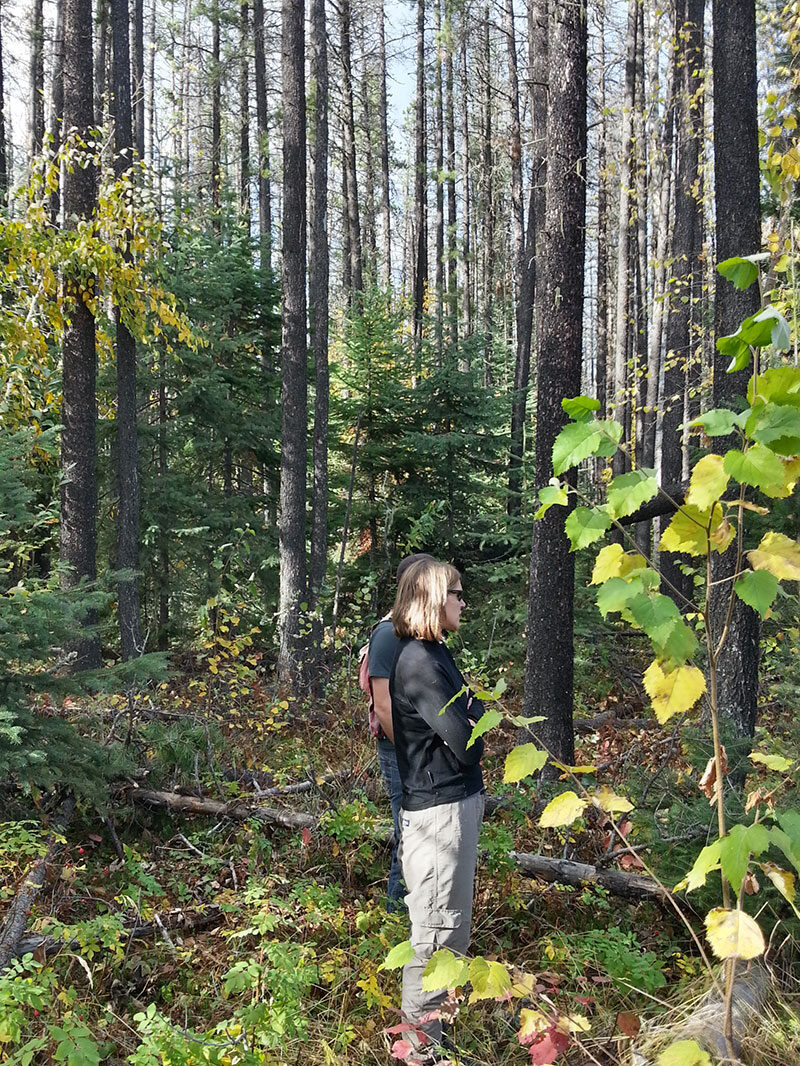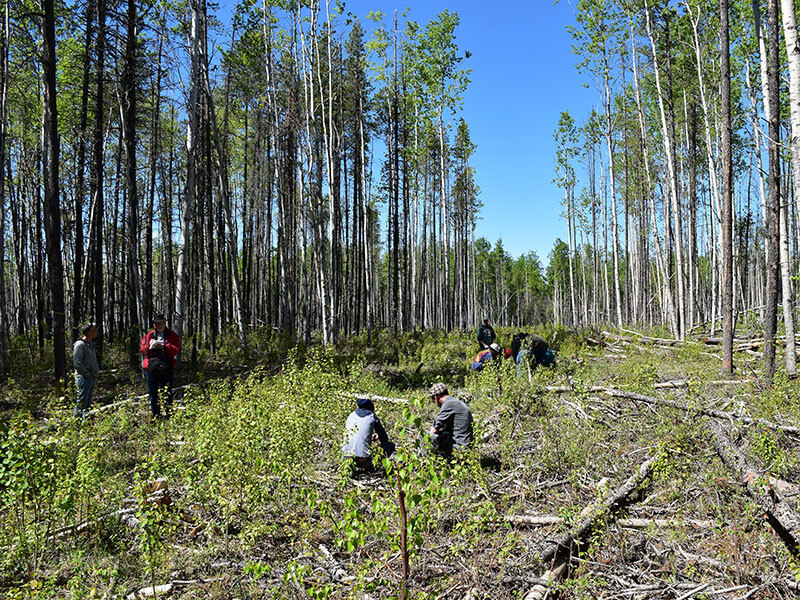
Stand Dynamics after Mountain Pine Beetle Attack
How will a stand respond after MPB infestation, and what can the forestry industry do to help it regenerate?
There are crucial questions asked by managers attempting to mitigate the impact of mountain pine beetle disturbance on timber and habitat supply. How long is killed-wood salvageable? What wood will be supplied by surviving trees? When will it regenerate?
Originally undertaken by the Foothills Growth and Yield Association and now continued by FGrOW, this project builds on previous research on lodgepole pine stands. The information collected and analysed will be used to inform timber supply analysis and operational planning through the improved development of stand regeneration and growth models forecasting post-disturbance conditions.
Problem Statement and Expected Outcomes
The rationale for this project originated during a multi-agency tour of MPB affected areas in B.C. in July 2007. The crucial questions asked by managers attempting to mitigate the impact of mountain pine beetle disturbance on timber and habitat supply were prioritized as:
- For how long will killed wood stand, provide forest cover and be salvageable?
- When, how much and what type of wood and forest cover will be supplied from surviving trees?
- When will wood and cover from new regeneration be available?
Given the government and industry strategy of proactive harvesting of attacked or endangered stands, the need was recognized for retention of a monitoring network of undisturbed permanent sample plots and buffer areas that would provide the basis for answering these and related questions.
This project, which is being undertaken by the Foothills Growth and Yield Association (FGYA), is a continuation of a project begun by the fRI Mountain Pine Beetle Ecology Program and the FGYA in 2008. The information collected and analysed will be used to inform timber supply analysis and operational planning through the improved development of stand regeneration and growth models forecasting post-disturbance conditions.
Investigators
- Dick Dempster, PhD, will act as principal investigator and be responsible for data analysis and scientific reports.
- Sharon Meredith, MScF, RPF, will be the project and data manager, responsible for overall project delivery, fieldwork coordination, and database management.
- John Stadt, MSc, will act as government collaborator and will provide liaison with ESRD, technical advice and input to scientific reports.
Objectives
The objective of the project is to assess the impact of MPB attack on lodgepole pine stand development in the absence of timber salvage or other management interventions. It builds on the work initiated in 2008 and will assess the following aspects of stand development.
- Rates of tree mortality and fall-down following MPB attack. Alberta forest managers are currently making various assumptions about rates of mortality and fall-down, based primarily on B.C. experience. Total, mean annual and current annual rates will be calculated for the first 6 years following detected attack.
- Natural regeneration of lodgepole pine without salvage or site preparation. The project will determine the total, mean annual and current annual rates of ingress by lodgepole pine and other acceptable coniferous species over the first 7 years following detected attack and determine if it is sufficient to produce a satisfactorily stocked stand under the Regeneration Standards of Alberta.
- Influence of site and stand variables on rates of tree mortality and regeneration. Natural sub-region, soil moisture regime, soil nutrient regime, over-storey stocking, and ground cone density have all demonstrated utility in predicting reforestation success in other FGYA studies and will be assessed in this project.
- Growth and abundance of non-tree vegetation and impact on tree regeneration. Growth and abundance of non-tree vegetation over the first 7 years following detected attack will be assessed against pre-attack levels. The relationship of these variables to tree regeneration stocking and height will be explored.
- Abundance of key wildlife food species will be affected by MPB attack. Selected food species will be tracked to 7 years following detected attack and assessed against pre-attack levels. Selection will focus on the requirements of caribou and grizzly bear with sampling protocols developed in collaboration with the fRI Grizzly Bear and Caribou Programs.
- The growth rate of residual trees and saplings. Testing of this hypothesis will be focused on growth of younger under-storey trees, and on the survival of non-attacked mature trees in the upper canopy.
Methods
The project will focus on monitoring changes in 63 plots already attacked by MPB in the Grande Prairie and Whitecourt forest areas before 2010. On these plots post-attack development will be assessed over a 7-year-plus period by 2016. A total of 105 plot re-measurements are scheduled for the period 2014 to 2016 (Table 1).
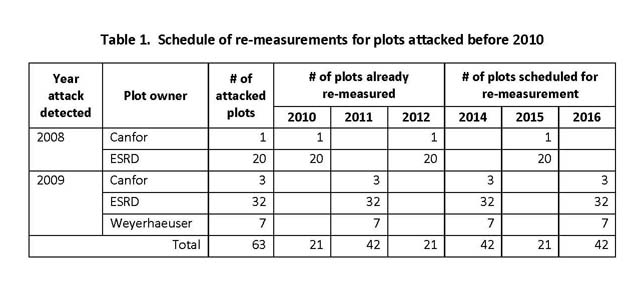
The 63 plots are part of a selection of 240 existing industrial and government permanent sample plots. They have baseline forest inventory data available, and were re-assessed within 2 years of attack. Measurement protocols were developed in collaboration with ESRD and University of Alberta scientists, including John Stadt (Provincial Forest Ecologist) and Dr. Ellen MacDonald (Professor, University of Alberta Department of Renewable Resources). Field measurements will be conducted between August 1 and 15 and include:
- Measurement of saplings and regeneration for all conifer and broadleaf tree species;
- Assessment of shrubs, herbs, grass, floor mosses, ground lichens, un-decayed wood, bare ground, and important caribou and grizzly bear food species;
- Ground cone counts and tree cone serotiny assessment;
- Identification green attack trees and trees that have died since last measurement, including cause of death; and
- Assessment of arboreal lichens.
The project kicks off with support from FGYA
Measurement work will continue with assistance from FGYA and ESRD
Data collection for regenerated lodgepole pine after MPB attack continues
Data collection objectives addressed, data entry underway



